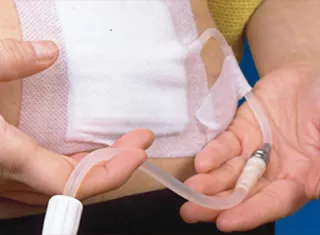
Managing fluids and diet as a patient on peritoneal dialysis (PD)
Your total weight = body weight + fluid weight
What should you do each day to balance your fluids?
- Weigh yourself
- Check and record your blood pressure
- Use the correct strength of dialysis solutions
- Look for signs of swelling and puffiness in your body
- Notice how you feel (e.g., shortness of breath)
- Pay attention to the types of food you eat and the amount you drink
- Restrict your fluids if needed, as advised by your healthcare provider
How do you know if you have too much fluid?
Too much fluid means “fluid overload,” which can strain your heart.
Symptoms of fluid overload:
- Shortness of breath
- Increase in weight
- Increase in blood pressure
- Swelling
What can you do if you have too much fluid?
- Follow the advice of your healthcare team
- Pay attention to your weight, breathing, blood pressure, and swelling
- Reduce your fluid intake
- Reduce your salt intake
- Your healthcare team may also use a stronger PD solution
- Call your healthcare provider if you are unsure
How do you know if you have too little fluid?
When you have too little fluid it is called “dehydration.”
Symptoms of dehydration:
- Tiredness
- Weakness
- Dizziness
- Lower blood pressure
What can you do if you have too little fluid?
Follow the advice of your healthcare team.
Some options may be to:
- Drink some liquids
- Use a lower-strength solution
- Not skip any exchanges





